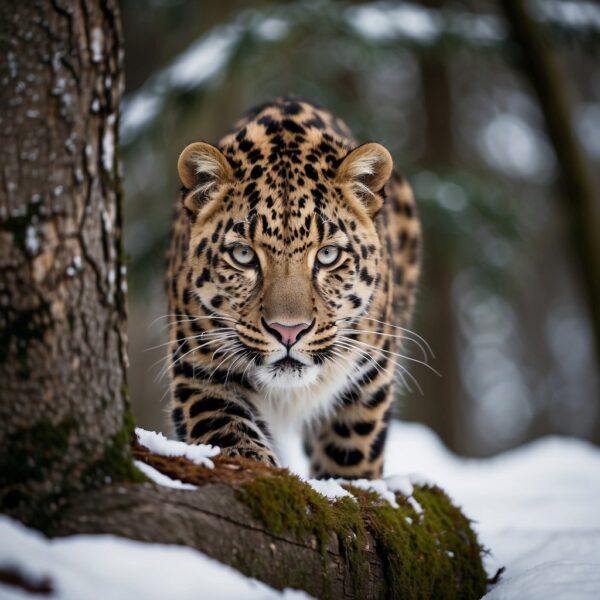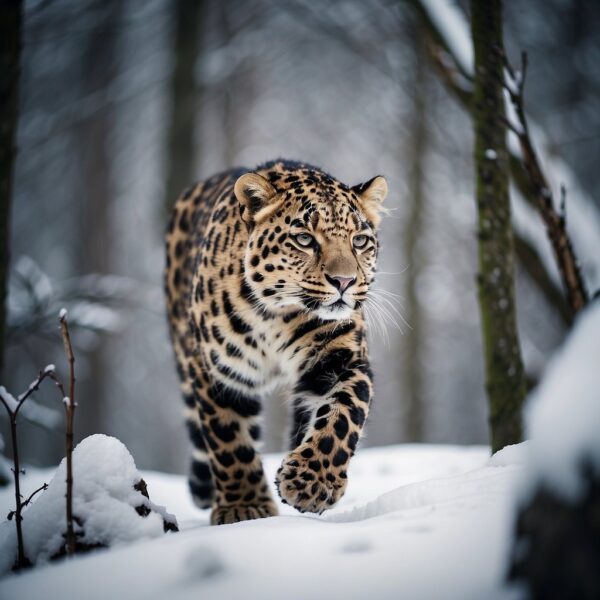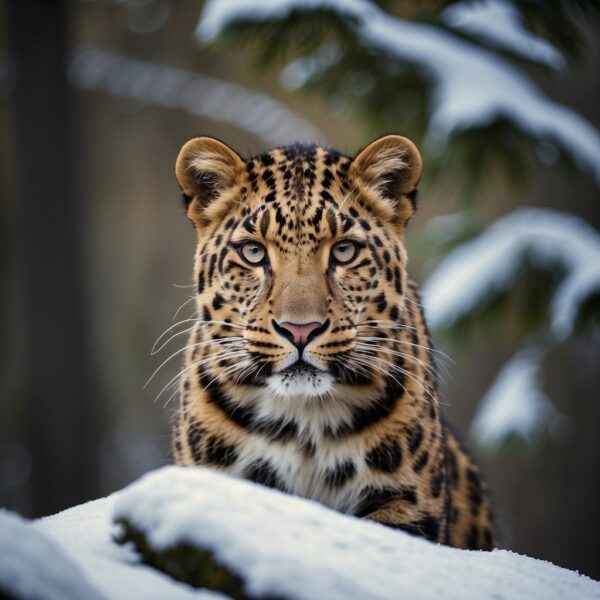
Amur Leopard: World’s Rarest Leopard
The Amur leopard is one of the world’s most endangered big cats, with a population that has faced the brink of extinction due to various threats. Endemic to the temperate forests of the Russian Far East and China, this elusive species has garnered significant attention from the global conservation community. Distinctive for its thick, pale coat – which is notably longer and denser than other leopard subspecies – the Amur leopard has adapted to the cold, snowy environment it inhabits.
Conservation efforts for the Amur leopard involve rigorous scientific research, habitat preservation, and international cooperation. Studies have monitored the leopard’s presence and movements to better understand habitat requirements, while also tracking threats to its survival such as poaching and habitat loss. Efforts to expand their habitat and control diseases like canine distemper have been critical in stabilizing populations. Despite the adverse conditions, recent conservation measures in both China and Russia offer a glimmer of hope for the future of this critically endangered species.
Key Takeaways
- The Amur leopard is a critically endangered species native to the Russia-China region.
- Conservation efforts are imperative due to threats like habitat loss and poaching.
- Scientific research and international conservation partnerships are key to the species’ survival.
Physical Characteristics
The Amur leopard is distinguished by its stunning fur pattern and robust build, epitomizing its adaptation to its habitat.
Fur Pattern
The Amur leopard’s fur is notably thick and is marked by rosettes, which provide excellent camouflage within their forested surroundings. In winter, their fur becomes even more thick to insulate against harsh cold, exhibiting a pale cream-colored base that contrasts with the distinct dark spots.
Size and Weight
- Male Amur leopards typically weigh between 32 to 48 kilograms (71 to 106 pounds).
- Female Amur leopards are generally smaller, weighing in at 25 to 42 kilograms (55 to 93 pounds).
In terms of size, these leopards possess a body length of approximately 107 to 136 centimeters (42 to 54 inches) with a tail adding an additional 82 to 90 centimeters (32 to 35 inches) to their length. The males are larger and more muscular compared to the females, which is typical for the species.
Habitat and Range
The Amur leopard, a rare subspecies of leopard, occupies a limited range characterized by specific ecological factors within the temperate forests of the Russian Far East and Northern China.
Geographical Distribution
The Amur leopard (Panthera pardus orientalis), primarily found in the Primorye region of southeastern Russia and northern parts of China, such as Jilin Province, is constrained to a compact and fragmented range. A significant portion of this range is centered around the Amur River Valley and extends into nearby areas of Manchuria, highlighting a cross-border distribution that is vital for the subspecies’ survival. The overall range has seen both contractions and expansions over the years, depending on conservation efforts, which have aimed at tackling threats and promoting habitat connectivity.
- Russian Far East: Remains a stronghold for the species, with Primorye region being a key area.
- Northern China: Habitat extends into Jilin Province and parts of Manchuria.
Temperate Forests
The preferred habitat of the Amur leopard is the temperate forest biome, which offers a blend of biodiversity and climate that suits the leopard’s adaptations. These forests are characterized by broad-leaf and mixed-wood trees, which provide both cover and ample prey. The temperate forests in the Amur River basin and its vicinity are crucial, as they support the deer populations that Amur leopards prey on. Habitat quality and availability in these regions — influenced by both natural factors and human activity — have direct implications on the robustness of the leopard population.
- Qualities of temperate forests:
- Mixed broad-leaf and coniferous trees.
- Sufficient prey base and understory cover for stalking.

Diet and Hunting Behavior
The Amur Leopard is a skilled predator with a diet comprising various species and a set of specialized hunting strategies that are crucial for its survival in the wild.
Prey Species
The Amur Leopard’s diet is diverse, including a range of prey animals. Major prey species consist of:
- Deer: Particularly, they favor Sika Deer and Roe Deer, which provide substantial nourishment.
- Wild Boar: These are significant to their diet, as they are abundant and offer high caloric value.
- Small Mammals: Smaller prey, including mice, are frequently hunted, adding variety to their diet and serving as prey when larger animals are scarce.
The presence of these species is vital for the sustenance of Amur Leopards in their natural habitat.
Hunting Strategies
Amur Leopards are predominantly nocturnal hunters and employ various strategies to catch different types of prey:
- Stealth and Ambush: Rely heavily on stealth, using foliage to conceal their approach before delivering a swift and powerful ambush.
- Stalking: They are known for patiently stalking their prey, maintaining a close distance before attacking at the opportune moment.
- Speed and Agility: They utilize their high-speed and agility to outmaneuver prey, particularly in dense forested areas where these abilities are advantageous.
Amur Leopard Conservation Status
The Amur leopard is a critically endangered species, with conservation efforts intensifying to prevent its extinction. International cooperation, particularly between Russia and China, plays a pivotal role in these attempts to ensure the survival and recovery of the species.
Population Decline
The wild population of Amur leopards has reached a critical low in recent decades. Classified as critically endangered on the IUCN Red List, the species faces a high risk of extinction in the wild. Historically, the population suffered from habitat loss, poaching, and human-wildlife conflict, leading to a significant decrease in numbers. Estimates of the population size indicate that there are fewer than 100 individuals remaining in the wild, mainly confined to the Russian Far East and Northeast China.
Conservation Efforts
Conservation efforts for the Amur leopard have been on the rise, with a focus on protected areas and anti-poaching measures. Land of the Leopard National Park, a protected area spanning over 2,600 square kilometers in Russia, acts as a safe haven for these leopards. The World Wildlife Fund, along with government agencies and non-governmental organizations, have directed resources towards improving monitoring and implementing conservation actions. Transboundary cooperation, especially with regional authorities in China, has been key to progress, resulting in habitat restoration and increased research efforts to better understand and support the recovery of the population.
Recent reports have shown a positive trend, suggesting an increase in the wild population, an outcome attributed to the synergistic conservation measures being employed. As part of these efforts, there is an increased emphasis on the importance of transboundary population monitoring, critical for gauging the efficacy of the conservation actions undertaken.
Threats to Survival
The Amur leopard faces critical threats that significantly impact its chances of survival, primarily due to habitat destruction and illegal activities like poaching.
Habitat Destruction
- Deforestation: The persistent removal of forests for timber and agriculture diminishes the critical habitat of the Amur leopard.
- Development: Expanding human development, including infrastructures such as oil pipelines, further fragments their living space.
- Forest Fires: Uncontrolled forest fires, often a result of human activities, destroy significant portions of the leopard’s habitat.
Poaching and Illegal Trade
- Hunting: Illegal hunting of the Amur leopard for its fur and body parts is a direct threat to its dwindling numbers.
- Wildlife Trade: The demand for leopard parts in the wildlife trade exacerbates the poaching issue.
- Prey Poaching: The hunting of prey species also contributes to the decline by reducing the Amur leopard’s food sources.
Scientific Research
Scientific research on the Amur leopard focuses on meticulously monitoring their populations and understanding their genetic health to ensure their conservation. Paramount to this is the utilization of advanced methodologies such as camera trapping and genetic sampling.
Monitoring amur leopard Populations
Camera traps have become an indispensable tool in the science of wildlife research, especially for elusive species like the Amur leopard. Researchers deploy these devices along the China–Russia border to assess leopard densities and distribution patterns. This non-invasive method provides vital data, informing conservationists about population trends and habitat use.
Population Monitoring Techniques:
- Camera Traps: Strategic placement in leopard habitats
- Route Surveys: Tracking of physical signs and sightings
- Data Analysis: Spatial distribution mapping and density calculations
Genetic Studies
The science of genetics offers insights into potential inbreeding issues within the Amur leopard population, which are critical for their long-term viability. Genetic studies help to identify levels of genetic diversity and disease susceptibility, informing breeding programs and habitat management strategies. Research in this domain is pivotal for understanding competition dynamics and ensuring the leopards’ genetic health.
Critical Genetic Research Aims:
- Diversity Analysis: Evaluating genetic variation to prevent inbreeding
- Disease Resistance: Identifying genetic factors linked to disease immunity
- Conservation Implications: Informing management practices to reduce genetic risks

Amur Leopard in Culture
The Amur leopard has held a place of significance in various cultural contexts, specifically within Northeast Asia. Through its symbolism and representation, this big cat has been both venerated and utilized as a cultural emblem.
Symbolism and Representation
Symbolism: The Amur leopard, as a carnivorous mammal and one of the most agile big cats, often symbolizes strength and adaptability in local cultures. It is not uncommon for this elusive feline to be depicted in art and folklore within communities where it historically roamed as a symbol of cunningness and a guardian of the wilderness.
Representation: In terms of cultural representation, the image of the Amur leopard has been used to evoke the fierce beauty and the fragile existence of wildlife within its habitat. Mammals such as the Amur leopard play a significant role in the biodiversity of the regions they inhabit, thus influencing cultural narratives about the importance of conservation and the human relationship with nature.
Local Communities: Local communities living in proximity to the habitats of the Amur leopard may incorporate this mammal into storytelling and cultural traditions, highlighting a deep connection and respect for these big cats.
Culture Impact: The presence of the Amur leopard in various forms of cultural expression underscores the mammal’s impact on human society. Their depiction in media, literature, and other cultural assets underlines the influence these majestic creatures have on the human psyche and the need for their protection.
Amur Leopard Interaction with Other Species
The Amur leopard, a critically endangered subspecies, navigates complex relationships with other species, particularly with Amur tigers and their shared ecosystem.
Coexistence with Tigers
The Amur leopard and the Amur tiger share overlapping territories in northeast China. These regions are often characterized by their biodiversity, particularly rich in ungulate species – like deer and wild boar – which serve as prey for both carnivores. Studies suggest that the presence of the Amur tiger influences Amur leopard behaviors, often resulting in the leopard avoiding areas of higher tiger density to minimize competition and potential predation risks. The intricate dynamics between these two top predators are critical in shaping their respective conservation strategies.
amur Leopard and Ecological Impact
Ungulates: As apex predators, both Amur leopards and tigers play an essential role in controlling the population of ungulates. This predation helps maintain a balanced ecosystem.
Ecosystem: The health of the ecosystem relies heavily on the presence of these carnivores. Their interactions with prey species and each other have cascading effects on vegetation and other wildlife, which in turn supports the biodiversity necessary for their survival.
By understanding the interactions of the Amur leopard with other species, conservationists can develop more effective strategies to protect this rare subspecies and the broader ecological community it supports.
Economic and Human Factors
The conservation of the Amur leopard involves complex interactions between local economic development and community engagement which are essential for the species’ survival amidst human-induced pressures.
Local Economic Development
Local economies are profoundly shaped by the environment and natural resources, with industries such as logging impacting the natural habitat of species like the Amur leopard. Economic development efforts must balance environmental sustainability with the growth imperative. Policies that limit destructive logging practices can mitigate habitat loss, but they must also address potential losses in local income to gain community support. Investment in rural developments, such as eco-tourism, can provide alternative revenue streams which align with conservation goals.
- Trade: Sustainable trade programs that benefit local industries without harming wildlife can bolster economic growth.
- Government: Policies are needed that both enhance economic opportunities for local communities and protect the Amur leopard.
Conservation and Community
Conservation initiatives must actively incorporate local communities to be effective. The development of programs that address human-wildlife conflict can pivot local perspectives from viewing leopards as a threat to valuing them as an integral part of the region’s identity and potential for economic development. Engaging communities in conservation efforts helps to foster a sense of ownership and responsibility towards the species.
- Education: Informing residents about the ecological role of the Amur leopard encourages community-led conservation.
- Partnership: Building partnerships between government, non-profit organizations, and communities leads to more sustainable conservation strategies.
Conservation Partnerships
The effectiveness of Amur leopard conservation efforts is significantly enhanced through international collaboration and the active involvement of non-governmental organizations (NGOs). These partnerships bridge geographical and political barriers, fostering a unified approach to the preservation of this endangered species.
International Collaboration
International collaboration is paramount in protecting the Amur leopard, with transboundary cooperation proving to be a successful strategy. Entities such as the World Wildlife Fund (WWF) are instrumental in these efforts, facilitating partnerships across nations. A notable example is the collaboration between China’s Land of the Leopard National Park and Russia to monitor and conserve the global population of Amur leopards. These collaborative efforts include sharing data and resources, which are vital for making informed conservation decisions.
- Key International Entities:
- WWF
- Land of the Leopard National Park
NGO Involvement
NGO involvement plays a crucial role in Amur leopard conservation. These organizations often act as catalysts for international partnerships, bringing together various stakeholders to create a unified front against threats to the species. The NEASPEC Partnership for Tiger and Leopard Conservation has been proposed to further strengthen the collaboration between governments and NGOs. Such partnerships are essential in developing and implementing comprehensive conservation strategies across the Amur leopard’s range.
- Notable NGOs:
- NEASPEC Partnership for Tiger and Leopard Conservation
- Various other conservation NGOs
amur leopard Frequently Asked Questions
This section addresses common inquiries regarding the plight, habitat, conservation measures, diet, characteristics, and status of the Amur leopard.
What factors have contributed to the endangerment of the Amur leopard?
The endangerment of the Amur leopard has been caused by habitat destruction, poaching, and a decrease in their natural prey. The impact of these factors has led to a critical reduction in their population in the wild.
How does the habitat of the Amur leopard affect its survival prospects?
The Amur leopard’s habitat impacts its survival by determining the availability of prey and the presence of human-induced threats. Suitable habitat allows for sufficient prey density and fewer encounters with poaching and human-wildlife conflicts.
What efforts are being made to increase the Amur leopard population?
Conservation efforts for the Amur leopard include habitat preservation, anti-poaching patrols, and breeding programs in captivity. International cooperation is also aimed at creating a larger, connected habitat for a genetically viable population.
What is the typical diet of the Amur leopard in the wild?
In the wild, the Amur leopard primarily feeds on roe deer, sika deer, hares, badgers, and other small mammals. Their diet reflects the availability of prey species in their habitat region.
Can you provide some key facts about the physical characteristics of the Amur leopard?
The Amur leopard is known for its thick fur, which is paler in winter, and dark, widely spaced rosettes with thick borders. It is well-adapted to cold environments and has long limbs that facilitate movement through snow.
What is the current conservation status of the Amur leopard?
The Amur leopard is classified as Critically Endangered on the IUCN Red List, with only around 100 individuals believed to be living in the wild, highlighting the urgent need for continued and enhanced conservation efforts.